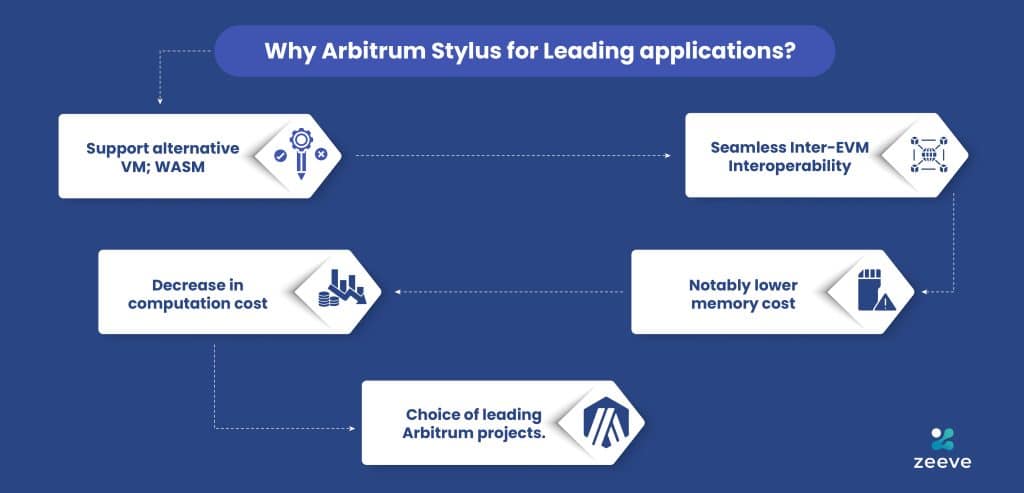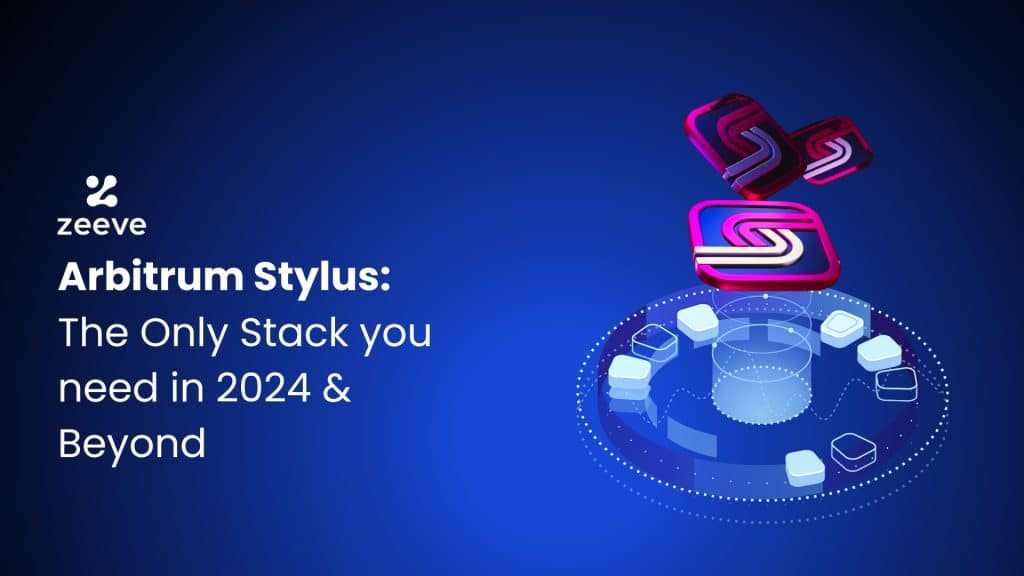2024 has been a promising year for Arbitrum with hundreds of new projects building on its ecosystem and 24+ Orbit L2/L3s launching on mainnet. Arbitrum Stylus is one of the main contributor to such Arbitrum’s growth. A series of leading projects, such as Renegade, Fairblock, Superposition, Crypto Valley Exchange, and Lit protocols are already building & thriving with Stylus. That’s because Stylus offers advanced tooling, abstractions, and features to make Stylus the most suited stack for top-grade applications in 2024.
The purpose of this article is to highlight the leading specific features of Arbitrum Stylus and discuss why it’s the best choice for top Arbitrum projects in 2024. Before that, if you are exploring Arbitrum Stylus, and want to learn more about it, here’s a detailed guide covering end-to-end details about Arbitrum Stylus in 2024.
Arbitrum Stylus: The Tangible Competitive Edge Your Rollups Badly Need

How Arbitrum Stylus offers the best stack for on-chain Applications in 2024?
Arbitrum Stylus offers the best suited stack for next-gen crypto applications such as DAOs operating through specific delegates, prediction markets, high-performance web3 gaming, AI-trained Bots for handling DeFi strategies, and tokenization platforms, more. Here are some of the top reasons why projects should choose to build with Arbitrum Stylus:
– WASM– altVM Support:
Arbitrum Stylus has added support for WASM, which is a popular alternative virtual machine available for Arbitrum developer environment. WASM is compatible with languages like Rust, C++, AssemblyScript offering more libraries for developers to utilize. Also, Stylus allows for seamless development of compilers to further support Move and Typescript. All the contracts written in the altVM languages will be interoperable with rest of the EVM contracts running on Arbitrum.
– Inter-EVM Interoperability:
Sytulus include a multi-VM architecture to enable seamless interoperability across EVMs. This means, if you are building an application like AI agent in Rust, it can still interact with contracts written in other languages like Solidity, C++, and C. Additionally, Stylus offers projects with the flexibility to keep their smart contracts 50-50% in Rust and Solidity, as required. This interoperability also allows applications on Arbitrum to interact with other applications running on a different chain. For example, a dApp on Arbitrum can interact with popular DeFi networks like GMX, and Camelot.
– Reduction in computation cost:
As discussed, Arbitrum ecosystem is growing with a wide range of innovative projects built for leading categories. To support these projects, the compute requirement expected to increase ten thousand folds by the end of 2030. Also, transactions fees in today’s advanced on-chain applications have been spotted comparatively more than other applications. Stylus eliminates both these major problems.
Firstly, it allows applications to be written in Stylus. This allows applications, mainly the compute intensive ones, to cut down the computation cost by around 10X. Also, Stylus has introduced ‘ink’ as a unit for computational cost, which is thousand time smaller than gas. Such granularity enable a more economical execution of complex operations in on-chain applications through implementation of traditional financial algorithm, such as Black-Scholes algorithms in Stylus stack. Learn in-depth information about Black-Scholes implementation from this detailed session.
– Notably lower memory cost:
Arbitrum Stylus implements a exponential, global memory pricing policy that reduces the aveage memory cost in on-chain AI applications by 100x and around 8MB storage per block.
Just like the computationally-intensive applications, there are a lot of high-traction applications that need improved on-chain memory. These includes:
- Massively populated DeFi networks.
- Highly sophisticated NLP models.
- Complex RWA models.
- Advanced computer vision algorithms.
- Play-and-earn web3 games
And, many more.

Top-05 All Time Hits of Arbitrum Stylus: Top Categories
Stylus is best suited for all kinds of mainstream applications like DeFi, DePIN, Gaming, or RWA, as it has become a powerful stack for compute-heavy projects that are building on Arbitrum. Let’s dive a little deeper:
1. DePIN– Avive World:
Avive World is a DePIN projects that offers a decentralized social world for geo-networking protocols with 9M+ users and top-grade developers. Avive World is really a vast network as it serves 8M+ users across 130+ countries and 20K cities. Avive Team chose Stylus due to its rapid deployment capabilities and the below key reasons:
- Inclusivity– Support for smart contracts development in Rust, C++, and C while allowing full compatibiloity with EVM.
- Ultra-low cost transactions- Executes transactions under a cent, maintaining cost-efficiency and optimal security.
- Enhanced efficiency: Boosted computation and memory through replacement of EVM bytecode with WASM.
2. Crypto X AI- Destra Network:
Destra Network is building its next-generation AI projects that is building its decentralized computing network. Destra is right now on its testnet and it has a current TVL of $6.62M. Destra enables applications to leverage the true decentralized AI backed with Destra GPU network and cutting-edge cloud solutions. Together with Arbitrum Orbit and Stylus stack, Destra is offering language flexibility for builders, EVM-interoperability, low-cost development, and more features. This opens up a broad spectrum for crypto x AI applications to fullfull their cloud, DePIN, and AI computing needs– all in one place.
3. Web3 Gaming- ApeChain:
ApeChain is one of the leading gaming projects on Arbitrum with over 17+ projects successfully deployed on it. ApeChain provides game developers and users with superior blockchain experience to focus on web3 rails, ecosystem discovery, and extensive funnel experience, ApeChain uses Arbitrum Orbit stack and Arbitrum One as the parent chain, which is the first to add support for Stylus. Hence, ApeChain leverages all the Stylus’ main features like smart contract languages, interoperability between EVMs, and the ability to offload the computational load.
4. DeFi- GMX
GMX is a standout DeFi project on Arbitrum that offers a new-gen decentralized exchange focused on perpetual and spot trading. GMX continues to grow and expand its current TVL of $671.38M and $3.96M+ trading volume. GMX uses Arbitrum Stylus stack to manage its governance model and expand its crypto ecosystem. Also, Stylus-powered features like low swap fees, high throughput, and EVM flexibility is offering unparalleled growth potential for GMX.
5. RWA- AlienX:
AlienX chain is one of top-performing NFTs chain on Arbitrum with over $1.1M TVL . AlienX has its massive focus on offering a powerful ecosystem for building NFT-based decentralized applications. Built on Arbitrum and powered by Stylus, AlienX is able to maintain high-performance network despite the tremendous growth of its ecosystem. Also, Stylus’ EVM-interoperability allows AlienX to maximize the staking reward and earning opportunities for users across different Arbitrum-based networks.
A brief about Stylus Sprint: How it is encouraging projects to buld on Arbitrum?
Apart from offering a powerful stack, Arbitrum is encouraging developers to experiment, innovate, and build future-proof applications through ‘Stylus Sprint’. The program is currently live and it is offering 5M ARB grants as reward to projects for building high-performance plus compute-specific applications, tooling for Stylus, or infrastructure. Hence, developers now have the opportunity to get paid for building their applications with Stylus. This program is an excellent means for projects to their hands on the Stylus stack and create interesting applications. Whereas for Arbitrum, it will surely drive mass adoption of Stylus stack in all the leading categories.
Tap into Stylus with Zeeve RaaS
Arbitrum Stylus is upgrading its stack continuously and it’s adding capabilities to make it a full-fledged stack for future applications, including AI applications that are surging on Arbitrum. If you are planning to utilize Stylus in your Arbitrum-based project or you want to build your use case-specific application with Stylus from scratch, Zeeve RaaS is the way to go. The Arbitrum Orbit stack at Zeeve is optimized to serve Stylus-specific projects, offering them fast execution, performance, and lower gas cost.
With Zeeve Raas, you can build crypto X projects or any use cases with over 40 third- party rollup integration services and you can set up a fully-functional testnet using a 1-click sandbox tool designed with all the essential integrations and configurations. For more information about Zeeve RaaS and Zeeve’s comprehensive blockchain offerings, connect with our experts. Or else, mail your project requirements/queries via mail.






















